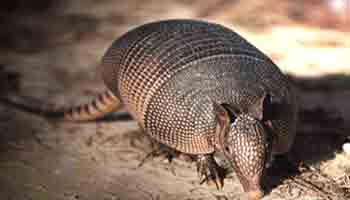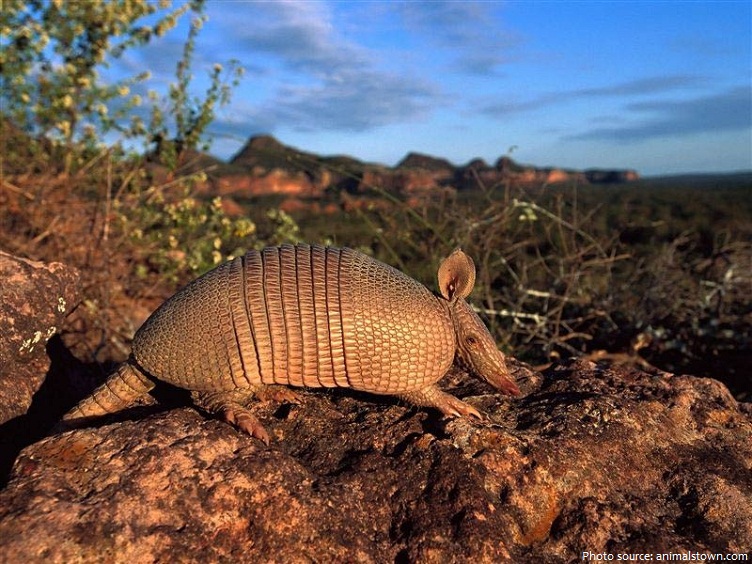

Underneath the carapace, its naked body appears wrinkly and pinkish in color. The head, tail and lower edges of the giant armadillo are nearly white, and the rest of the body is dark brown. Their heads are also covered with a similar oval shield.

The necks and backs of armadillos are covered with flexible carapaces (shells) consisting of 14 to 17 moveable bands of horn and bone. Adults grow as long as 35 inches and can weigh over 70 lb. Without intervention, this trend is likely to continue.The giant armadillo is the largest of all armadillos and found in South America, east of the Andes, from northwestern Venezuela to northeastern Argentina. Current estimates indicate the giant armadillo may have undergone a worrying population decline of 30 to 50 percent over the past three decades.

This is further exacerbated by habitat loss resulting from deforestation. Despite this species’ wide range, it is locally rare. In addition, live giant armadillos are frequently captured for trade on the black market, and invariably die during transportation or in captivity. Hunted throughout its range, a single giant armadillo supplies a great deal of meat, and is the primary source of protein for some indigenous peoples. The average sleep time of a captive giant armadillo is said to be 18.1 hours. Little is currently known about this species' reproductive biology, and no juveniles have ever been discovered in the field. The diet is mainly composed of termites, although ants, worms, spiders and other invertebrates are also eaten. Giant armadillos use their large front claws to dig for prey and rip open termite mounds. They also burrow to escape predators, being unable to completely roll into a protective ball. Giant armadillos are fairly solitary and nocturnal, spending the day in burrows. Because of this, the species is considered habitat engineer, and the local extinction of Priodontes may have cascading effects in the mammalian community by impoverishing fossorial habitat (Leite Pitman et al 2004). In the only long term study on the species, that started in 2003 in the Peruvian Amazon, dozen of another species of mammals, reptiles and birds were found using the giant armadillo burrows at the same day, including the rare short-eared dog (Atelocynus microtis). The typical length of the species is 75–100 cm (30–39 in), with the tail adding another 50 cm (20 in).ĭistribution and habitat Biology and behaviorĪrmadillos have not been extensively studied in the wild therefore, little is known about their natural ecology and behavior. The giant armadillos typically weigh around 28–32 kg (62–71 lb) when fully grown, however a 54 kg (119 lb) specimen has been weighed in the wild and captive specimens have been weighed up to 80 kg (180 lb). They also possess extremely long front claws, including a sickle-shaped third claw. These armadillos have around 80 to 100 teeth, which is more than any other terrestrial mammal. Its body is dark brown in color, with a lighter, yellowish band running along the sides, and a pale, yellow-white head. The giant armadillo is the largest living species of this group, and has 11 to 13 hinged bands protecting the body, and a further three or four on the neck. Habitat loss, especially through logging, has caused numbers to fall to just a few thousand animals scattered across the continent.Īrmadillos are two of the oldest groups of mammals and have a quirky appearance, with a tough shell composed of bony plates in the dermis covered by horny scales.

It lives alone, sheltering by day in burrows dug with its claws. The South American giant armadillo is a mammal covered in armour-plating made of horn and born. It also has been known to prey upon worms, larvae and larger creatures, such as spiders and snakes, and plants.Īt least one zoo park, in Villavicencio, Colombia – Los Ocarros – is dedicated to this animal. The giant armadillo prefers termites and some ants as prey, and often consumes the entire population of a termite mound. This species is considered vulnerable to extinction. It was once found widely throughout the tropical forests of South America and now ranges throughout varied habitat as far south as northern Argentina. The Giant armadillo ( Priodontes maximus), colloquially tatou, ocarro, tatu-canastra or tatú carreta, is the largest living species of armadillo (although the extinct glyptodonts were much larger). Once found widely throughout the tropical forests of South America and now ranges throughout varied habitat as far south as northern Argentina. Tatou, Ocarro, Tatu-canastra or Tatú Carreta.


 0 kommentar(er)
0 kommentar(er)
